Biking with your dog on a leash is a fantastic way to exercise together and explore the outdoors; usabikers.net provides you the ultimate guide. With the right gear, training, and safety precautions, biking with your canine companion becomes a joyful adventure, enhancing your bond and providing mental and physical stimulation for both of you, creating lasting memories on two wheels, so start exploring dog biking accessories, safety tips for dog biking, and leash options for biking with dogs.
Here’s a comprehensive guide to safely and enjoyably biking with your dog on a leash:
1. Is Biking With My Dog On A Leash Safe?
Yes, biking with your dog on a leash can be safe with proper preparation, training, and the right equipment. Prioritize your dog’s safety and well-being, consult with your vet, and gradually introduce them to biking, resulting in enjoyable and safe adventures.
- Veterinary Consultation: Consulting with your vet before starting any new exercise routine, especially biking, helps ensure the safety of your beloved canine companion. According to the American Veterinary Medical Association (AVMA), a vet can evaluate your dog’s breed, age, and overall health, identifying potential risks and providing personalized recommendations. They can assess for conditions like hip dysplasia or arthritis, which may make biking uncomfortable or unsafe.
- Proper Gear: Investing in the right gear is essential for the safety and comfort of both you and your dog. A specialized bike leash, such as the “bike tow leash” recommended by experts, keeps your dog a safe distance from the bike and prevents them from pulling you off balance. A well-fitted harness, rather than a collar, distributes pressure evenly and minimizes strain on your dog’s neck.
- Gradual Introduction: Rushing into long bike rides can lead to injuries and negative experiences for your dog. Gradually introduce them to the bike, allowing them to sniff and explore it while stationary. Then, progress to short walks with the bike, followed by short rides in a safe environment.
- Training and Socialization: Basic obedience training and socialization are crucial for safe biking with your dog. Teach commands like “sit,” “stay,” “heel,” and “wait” to maintain control and prevent accidents. Socializing your dog by exposing them to various environments, people, and animals can help them remain calm and non-reactive during bike rides.
- Awareness of Surroundings: Staying attentive and responsive to your dog’s behavior is essential for preventing accidents. Watch for signs of fatigue, stress, or discomfort, such as excessive panting, lagging behind, or reluctance to continue. Be mindful of potential hazards like off-leash dogs, car traffic, and pedestrians, and take appropriate action to avoid them.
2. What Are The Essential Gears For Biking With My Dog On A Leash?
The essential gear for biking with your dog on a leash includes a suitable bike leash, a well-fitted harness, water and a dish, dog treats, a regular leash, and poo bags. Choosing high-quality gear and ensuring a comfortable fit enhances your and your dog’s safety and enjoyment.
2.1. Bike Leash
A bike leash keeps your dog a safe distance from the bike, maintaining stability. The “bike tow leash” is a reliable option, preventing your dog from pulling you off balance.
2.2. Harness
A well-fitted harness distributes pressure evenly, preventing strain on your dog’s neck. Ruffwear’s front range harness is a comfortable and secure option.
2.3. Water Bottle and Dish
Staying hydrated is crucial. Bring a water bottle and a collapsible dish for easy access during breaks, ensuring your dog remains refreshed and comfortable.
2.4. Dog Treats
Dog treats are essential for positive reinforcement. Rewarding good behavior encourages your dog and strengthens your bond during the ride.
2.5. Regular Leash
A regular leash is useful for breaks and bathroom stops. It provides control and ensures your dog remains secure when not biking.
**2.6. Poo Bags
Poo bags are essential for responsible pet ownership. Always clean up after your dog to keep trails clean and enjoyable for everyone.
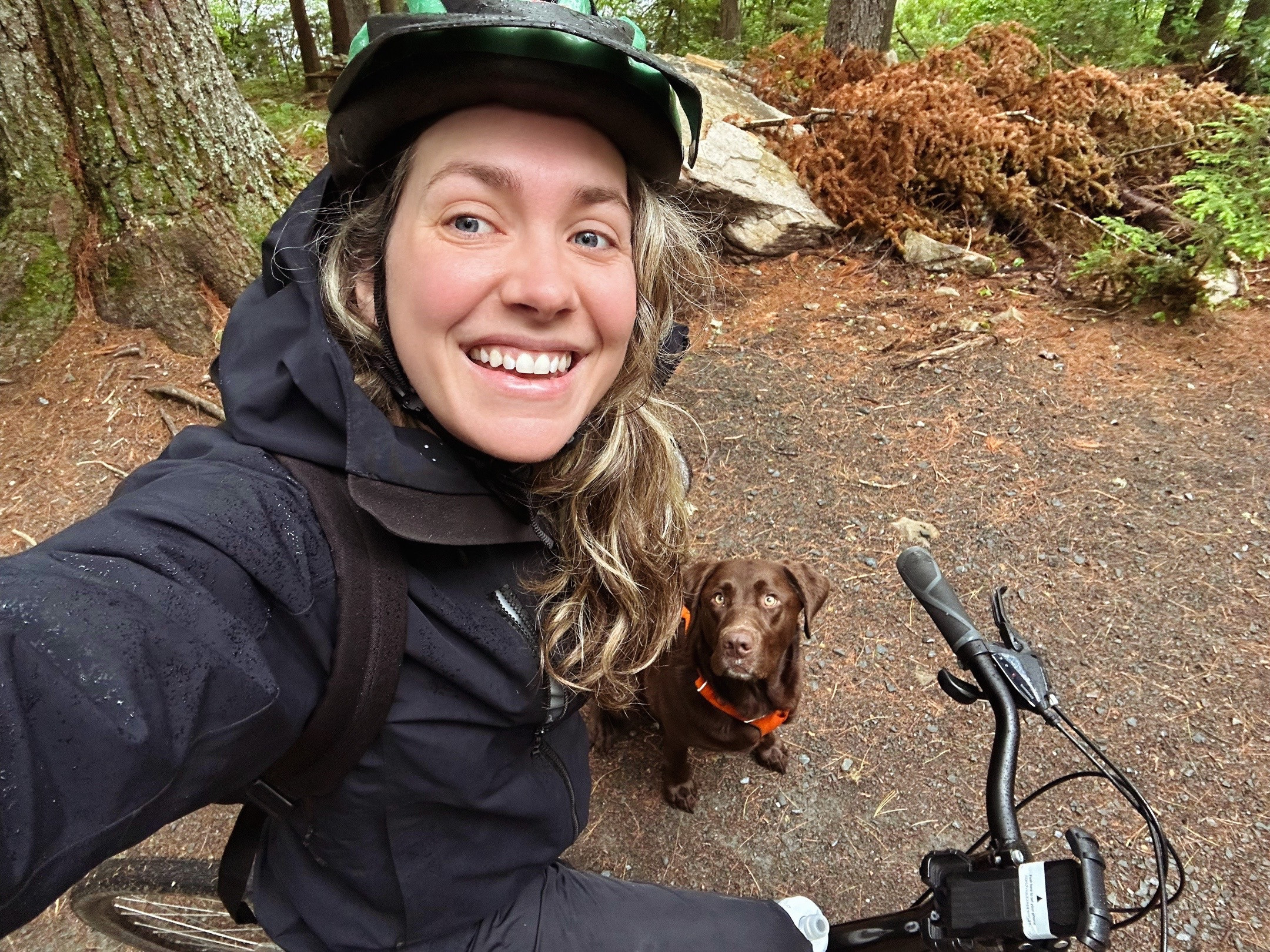 Biking with my dog, Moose!
Biking with my dog, Moose!
2.7. Additional Considerations
- Bike Helmet: Always wear a helmet to protect yourself in case of accidents, setting a responsible example.
- Hand Signals: Use hand signals to indicate turns and stops, alerting others to your intentions.
- Bike Bell: Install a bike bell to warn pedestrians and other cyclists of your approach, improving safety.
3. How Do I Choose The Right Bike Leash?
Choosing the right bike leash involves considering safety, durability, and control. Select a leash that keeps your dog a safe distance from the bike, prevents entanglement, and allows you to maintain balance.
- Safety Considerations:
- Distance: Ensure the leash keeps your dog far enough from the bike to prevent accidents.
- Entanglement: Opt for a design that minimizes the risk of the leash getting tangled in the wheels or pedals.
- Durability:
- Material: Look for leashes made from high-quality, durable materials that can withstand pulling and wear.
- Construction: Check for reinforced stitching and sturdy hardware to ensure the leash can handle your dog’s strength.
- Control:
- Attachment Point: Choose a leash that attaches to the bike frame or seat post rather than the handlebars, providing more stability.
- Flexibility: A leash with some flexibility can absorb shocks and prevent sudden jerks.
- Types of Bike Leashes:
- Fixed Leashes: These leashes have a fixed length and attach to the bike frame. They offer more control but less flexibility.
- Spring-Loaded Leashes: These leashes have a spring mechanism that absorbs shocks and reduces strain on both you and your dog.
- Side-Mounted Leashes: These leashes attach to the side of the bike and keep your dog a safe distance away.
- Leashes to Avoid:
- Handlebar-Attached Leashes: These can compromise steering and balance.
- Retractable Leashes: These offer little control and pose a risk of entanglement.
- Top Recommendations:
- Bike Tow Leash: Known for its sturdy construction and ability to keep dogs safely to the side.
- Walky Dog Bike Leash: A popular option with a spring-loaded system for shock absorption.
4. What Are The Best Harnesses For Biking With A Dog?
The best harnesses for biking with a dog should be well-fitted, comfortable, and durable, distributing pressure evenly to prevent strain.
- Key Features to Look For:
- Comfortable Padding: Ensures your dog remains comfortable during longer rides.
- Adjustable Straps: Allows for a snug and secure fit without restricting movement.
- Durable Materials: Withstands pulling and wear.
- Front and Back Attachment Points: Provides versatility for different biking styles and control preferences.
- Top Harness Recommendations:
| Harness | Features | Benefits |
|---|---|---|
| Ruffwear Front Range Harness | Padded chest and belly panel, adjustable straps, front and back attachment points | Comfortable fit, easy to put on and take off, versatile for walking and biking |
| Kurgo Tru-Fit Smart Harness | Crash-tested, adjustable straps, chest pad, seatbelt loop | Safe for car rides, comfortable for biking, prevents strain during sudden stops |
| Rabbitgoo Dog Harness | No-pull design, adjustable straps, breathable mesh, front and back attachment points | Distributes pressure evenly, comfortable in warm weather, reduces pulling |
| Eagloo Dog Harness | Step-in design, adjustable straps, reflective stitching, breathable mesh | Easy to put on and take off, enhances visibility in low light, comfortable for long rides |
| OneTigris Tactical Dog Harness | Durable nylon, padded interior, adjustable straps, MOLLE webbing for attaching accessories | Rugged construction, comfortable fit, allows for carrying water bottles and other essentials, suitable for adventurous bikers and their dogs |
- Fitting the Harness:
- Measure Your Dog: Use a soft measuring tape to measure your dog’s chest and neck circumference.
- Adjust the Straps: Ensure the harness fits snugly but doesn’t restrict movement. You should be able to fit two fingers between the harness and your dog’s body.
- Check for Chafing: Monitor your dog for signs of chafing or discomfort during the first few rides.
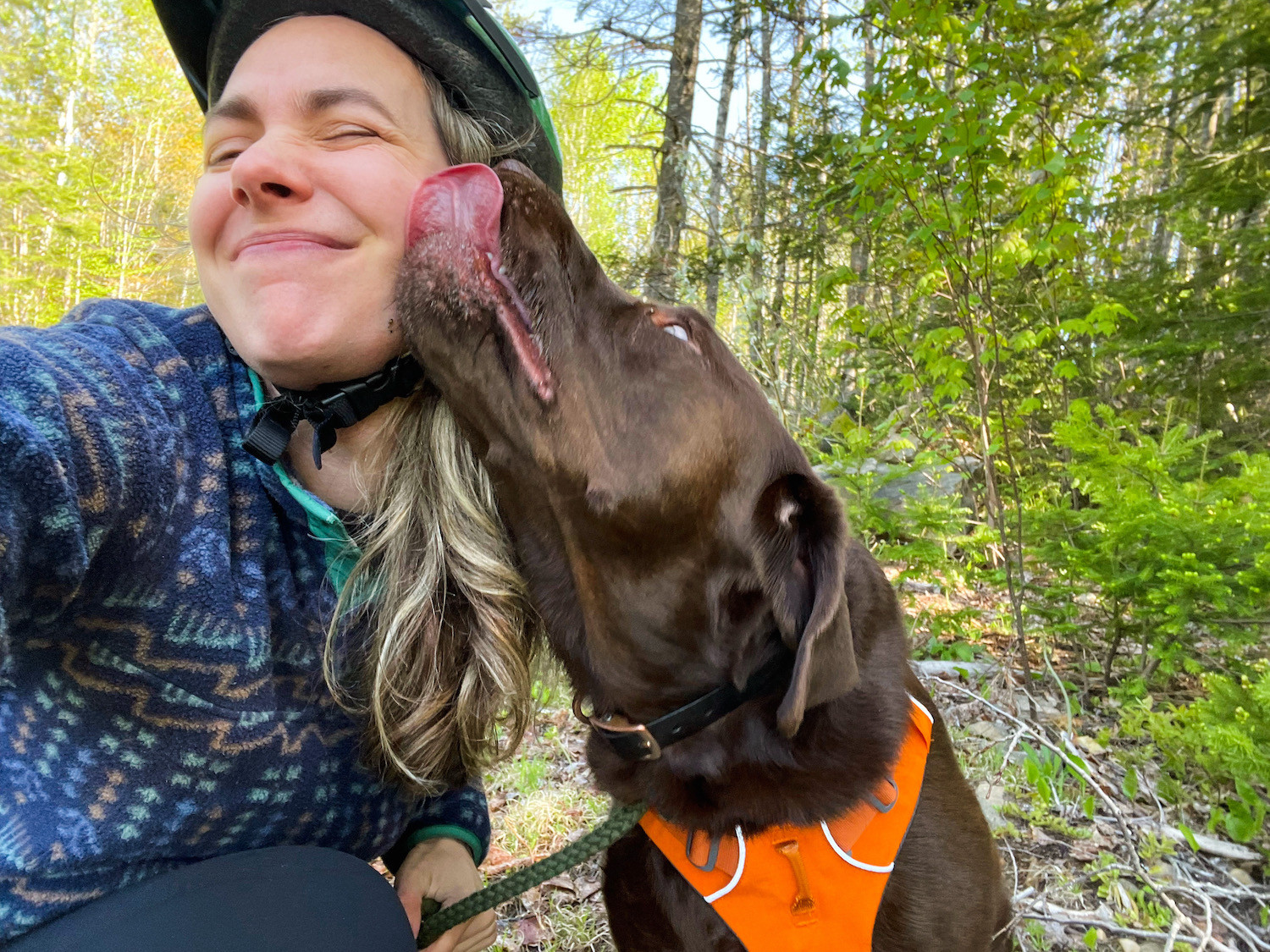 Jen Moose.jpeg
Jen Moose.jpeg
5. What Basic Training Should My Dog Know Before Biking?
Before biking with your dog, ensure they know basic commands like “sit,” “stay,” “heel,” and “wait.”
- Essential Commands:
- Sit: Teaches your dog to sit on command, which is useful for stops.
- Stay: Keeps your dog in place, preventing them from running into traffic or other hazards.
- Heel: Trains your dog to walk beside you without pulling, maintaining control during rides.
- Wait: Prevents your dog from darting ahead, ensuring they remain safe during starts and stops.
- Additional Useful Commands:
- Leave It: Stops your dog from picking up dangerous objects or food.
- Look at Me: Directs your dog’s attention to you, helping them focus on your commands.
- Slow: Reduces your dog’s pace, preventing them from getting too far ahead.
- Training Techniques:
- Positive Reinforcement: Reward your dog with treats and praise for good behavior, encouraging them to follow commands.
- Consistency: Use the same commands and hand signals every time to avoid confusion.
- Short Sessions: Keep training sessions short and frequent, maintaining your dog’s interest.
- Practice in Different Environments: Train your dog in various locations, helping them generalize their skills.
- Socialization:
- Expose Your Dog to Different Stimuli: Introduce your dog to various sights, sounds, people, and animals to help them remain calm and non-reactive during bike rides.
- Reward Calm Behavior: Praise and reward your dog for remaining calm in the presence of distractions, reinforcing positive associations.
6. How Do I Introduce My Dog To The Bike?
Introducing your dog to the bike involves gradual exposure and positive reinforcement. Start by letting them explore the bike, then progress to short walks, and eventually, short rides.
- Initial Introduction:
- Let Your Dog Explore the Bike: Allow your dog to sniff and explore the bike while it’s stationary.
- Reward with Treats and Praise: Give your dog treats and praise for interacting calmly with the bike, creating positive associations.
- Short Walks:
- Walk with the Bike: Take your dog for short walks with the bike, holding the leash in one hand and pushing the bike with the other.
- Gradually Increase Distance: Slowly increase the distance of your walks, allowing your dog to become more comfortable with the bike’s presence.
- Short Rides:
- Start in a Safe Environment: Begin with short rides in a safe, controlled environment, such as a park or quiet street.
- Keep Rides Short: Limit the duration of your initial rides to a few minutes, preventing your dog from becoming overwhelmed.
- Monitor Your Dog’s Behavior: Watch for signs of stress or discomfort, adjusting your pace or taking breaks as needed.
- Positive Reinforcement:
- Encourage Good Behavior: Praise and reward your dog for staying by your side, responding to commands, and remaining calm during the ride.
- Use Verbal Praise: Use positive verbal cues, such as “good job” or “yes,” to reinforce desired behaviors.
- Give Treats: Offer treats to reward your dog for following commands and remaining calm during the ride.
- Introducing Distractions:
- Gradually Introduce Distractions: Once your dog is comfortable with biking, gradually introduce distractions like other cyclists, pedestrians, and dogs.
- Maintain Control: Keep your dog on a leash and maintain control, preventing them from lunging or chasing distractions.
- Reward Calm Behavior: Praise and reward your dog for remaining calm in the presence of distractions, reinforcing positive associations.
7. How Should I Start Biking With My Dog On A Leash?
Start biking with your dog on a leash slowly, gradually increasing the duration and distance of your rides. Begin with a warm-up walk and end with a cool-down to prevent injuries.
- Warm-Up:
- Short Walk: Begin your bike ride with a short walk to warm up your dog’s muscles, preparing them for exercise.
- Stretching: Encourage your dog to stretch by reaching for treats or toys, improving flexibility.
- Initial Rides:
- Short Duration: Limit the duration of your initial rides to 10-15 minutes, preventing your dog from becoming fatigued.
- Slow Pace: Maintain a slow, steady pace, allowing your dog to keep up without straining.
- Flat Terrain: Choose flat, even terrain for your initial rides, avoiding hills and rough surfaces.
- Gradually Increase Duration and Distance:
- Increase Gradually: Slowly increase the duration and distance of your rides over time, allowing your dog to build stamina.
- Monitor Your Dog’s Condition: Watch for signs of fatigue, stress, or discomfort, adjusting your pace or taking breaks as needed.
- Cool-Down:
- Slow Pace: End your bike ride with a slow pace, allowing your dog’s heart rate to gradually decrease.
- Walk: Finish with a short walk to cool down your dog’s muscles, preventing stiffness and soreness.
8. How Do I Know My Dog’s Limits While Biking?
Knowing your dog’s limits while biking involves paying close attention to their behavior and physical condition. Watch for signs of fatigue, stress, or discomfort.
- Signs of Fatigue:
- Excessive Panting: Heavy panting can indicate that your dog is overheating or struggling to keep up.
- Lagging Behind: If your dog starts lagging behind or slowing down, they may be tired.
- Reluctance to Continue: If your dog becomes reluctant to continue or stops frequently, they may be exhausted.
- Signs of Stress:
- Whining or Barking: Excessive whining or barking can indicate that your dog is stressed or uncomfortable.
- Tail Tucking: A tucked tail can be a sign of fear or anxiety.
- Lip Licking or Yawning: These behaviors can indicate stress or discomfort.
- Signs of Discomfort:
- Limping: Limping can indicate a strain, sprain, or other injury.
- Paw Licking: Excessive paw licking can indicate irritation or injury.
- Reluctance to Put Weight on a Limb: This can be a sign of pain or injury.
- Adjusting Your Pace and Distance:
- Adjust Your Pace: If your dog shows signs of fatigue, stress, or discomfort, slow down your pace or take a break.
- Shorten Your Ride: If your dog is struggling, shorten your ride and return home.
- Take Breaks: Stop frequently to allow your dog to rest, drink water, and relieve themselves.
 Bike tow leash makes biking with you dog easy
Bike tow leash makes biking with you dog easy
9. How Do I Choose Dog-Friendly Biking Routes?
Choosing dog-friendly biking routes involves selecting locations that permit dogs, have minimal distractions, and offer safe surfaces. Look for parks, trails, and paths that cater to dogs.
- Dog-Friendly Locations:
- Parks: Many parks allow dogs on leash, providing a safe and scenic environment for biking.
- Trails: Look for multi-use trails shared by hikers and cyclists, offering wide lanes and minimal traffic.
- Paths: Choose paved or gravel paths that are easy on your dog’s paws, avoiding rough or rocky terrain.
- Minimizing Distractions:
- Low Traffic Areas: Select routes with minimal car traffic, reducing the risk of accidents.
- Leash Regulations: Opt for trails that require dogs to be on leash, preventing encounters with off-leash animals.
- Safe Surfaces:
- Paved or Gravel Paths: Choose paths that are easy on your dog’s paws, reducing the risk of injury.
- Avoid Hot Pavement: Avoid biking on hot pavement during warm weather, as it can burn your dog’s paw pads.
- Additional Considerations:
- Shaded Areas: Look for routes with shaded areas, providing relief from the sun and preventing overheating.
- Water Access: Choose routes near lakes, rivers, or streams, allowing your dog to cool off and stay hydrated.
- Checking Local Regulations:
- Review Park and Trail Rules: Before heading out, review the rules and regulations of the park or trail to ensure dogs are permitted and to understand any specific requirements.
10. How Does Temperature Affect Biking With My Dog?
Temperature significantly affects biking with your dog. Avoid biking during extreme heat or cold, as dogs are more susceptible to temperature-related health issues.
- Heat:
- Overheating: Dogs can overheat quickly, leading to heatstroke.
- Paw Burns: Hot pavement can burn your dog’s paw pads.
- Safe Temperatures: Avoid biking when the temperature exceeds 68°F (20°C).
- Cold:
- Frostbite: Dogs can get frostbite on their paws, ears, and tail.
- Hypothermia: Prolonged exposure to cold can lead to hypothermia.
- Safe Temperatures: Avoid biking when the temperature is below freezing (32°F or 0°C).
- Protective Gear:
- Booties: Use dog booties to protect your dog’s paws from hot pavement or cold temperatures.
- Coats: Dress your dog in a coat to provide insulation and warmth during cold weather.
- Timing Your Rides:
- Morning or Evening: Bike during the cooler parts of the day, such as early morning or late evening.
- Avoid Midday: Avoid biking during the hottest part of the day, typically between 10 a.m. and 4 p.m.
- Monitoring Your Dog:
- Watch for Signs of Discomfort: Pay close attention to your dog’s behavior, looking for signs of overheating or hypothermia.
- Take Breaks: Stop frequently to allow your dog to rest, drink water, and cool down or warm up.
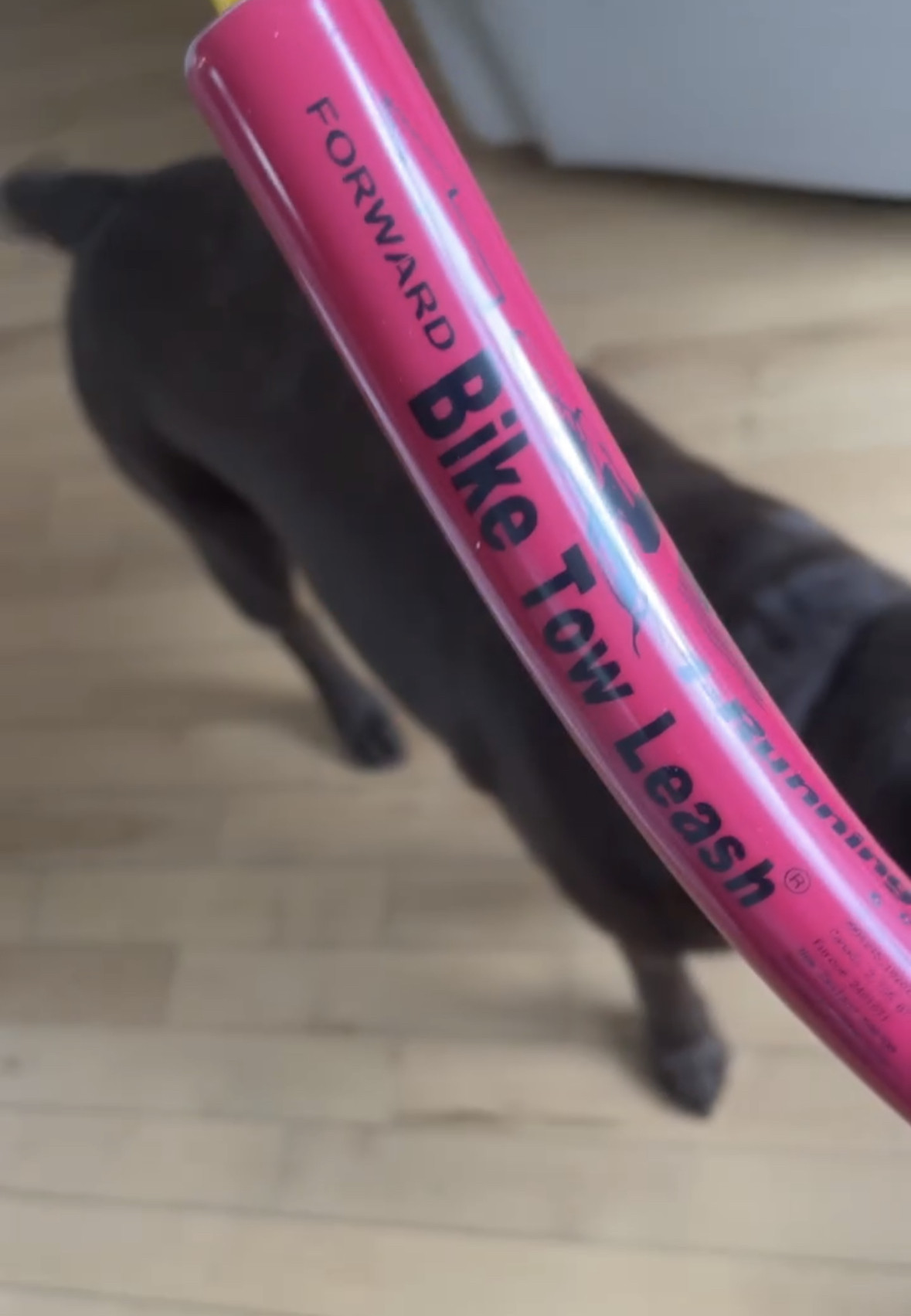 Bike tow leash for biking with your dog
Bike tow leash for biking with your dog
11. How Can I Prioritize Safety While Biking With My Dog On A Leash?
Prioritizing safety while biking with your dog on a leash involves wearing a helmet, using hand signals, installing a bike bell, and staying vigilant.
- Personal Safety:
- Wear a Helmet: Always wear a helmet to protect your head in case of accidents.
- Hydrate Yourself: Drink plenty of water to stay hydrated during your ride.
- Use Hand Signals: Use hand signals to indicate turns and stops, alerting others to your intentions.
- Install a Bike Bell: Use a bike bell to warn pedestrians and other cyclists of your approach.
- Dog Safety:
- Keep Your Dog on a Leash: Always keep your dog on a leash to maintain control and prevent accidents.
- Use a Bike Leash: Use a specialized bike leash to keep your dog a safe distance from the bike and prevent entanglement.
- Monitor Your Dog’s Condition: Pay close attention to your dog’s behavior, looking for signs of fatigue, stress, or discomfort.
- Environmental Awareness:
- Stay Attentive: Remain attentive to your surroundings, watching for potential hazards like cars, pedestrians, and other animals.
- Choose Safe Routes: Select routes with minimal traffic and safe surfaces, avoiding rough or rocky terrain.
- Follow Local Regulations: Adhere to local regulations regarding dogs in public spaces, ensuring you are in compliance with leash laws and other requirements.
- Emergency Preparedness:
- Carry a First Aid Kit: Bring a first aid kit for both you and your dog, addressing minor injuries.
- Know Emergency Contacts: Have emergency contact information readily available, including your veterinarian’s phone number and local emergency services.
12. Why Is Regular Bike Maintenance Important?
Regular bike maintenance ensures your bike remains in safe working condition, preventing accidents and improving performance. Before every ride, check your bike’s tire pressure, brakes, and leash.
- Tire Pressure:
- Check Before Each Ride: Ensure your tires are properly inflated before each ride, improving handling and preventing flats.
- Use a Tire Gauge: Use a tire gauge to check the pressure, inflating to the recommended level.
- Brakes:
- Test Before Each Ride: Test your brakes before each ride, ensuring they are responsive and effective.
- Adjust as Needed: Adjust your brakes as needed, ensuring they provide adequate stopping power.
- Leash Inspection:
- Check for Wear and Tear: Inspect your bike leash for signs of wear and tear, such as frayed edges or loose hardware.
- Replace if Damaged: Replace your leash if it is damaged, preventing accidents.
- Professional Tune-Ups:
- Schedule Regular Tune-Ups: Schedule regular tune-ups with a professional bike shop or mechanic.
- Comprehensive Inspection: A tune-up includes a comprehensive inspection of your bike, addressing any issues that may affect safety or performance.
- Maintenance Tasks:
- Wheel Truing: Ensure your wheels are true and aligned, improving handling and preventing wobble.
- Drivetrain Cleaning: Clean and lubricate your drivetrain, improving shifting and reducing wear.
- Bearing Adjustments: Adjust your bearings, ensuring smooth and efficient operation.
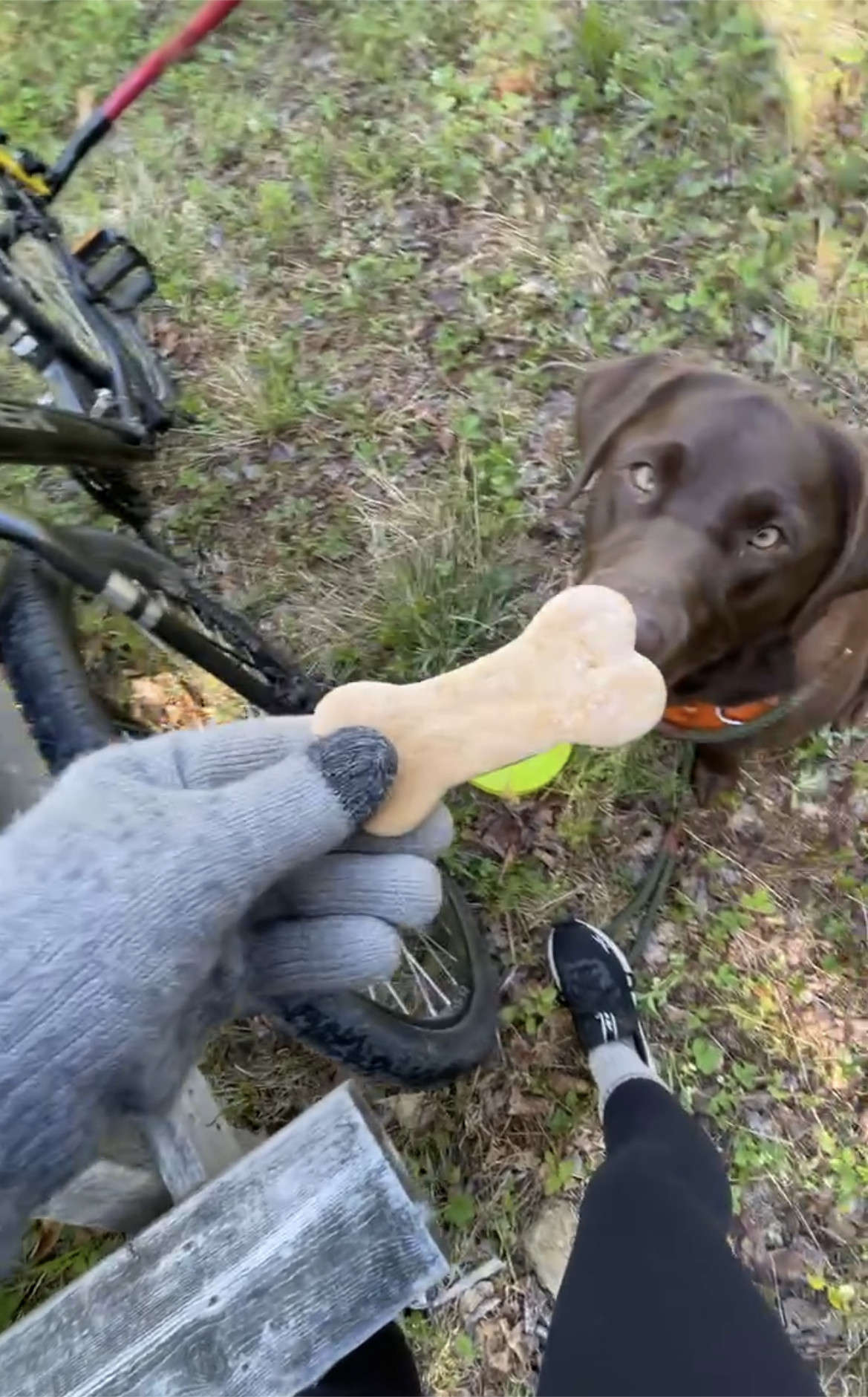 Stopping for some treats
Stopping for some treats
13. What If My Dog Doesn’t Like Biking?
If your dog consistently displays fear, anxiety, or resistance to biking, don’t force them. Not all dogs enjoy biking, so find alternative activities you can enjoy together.
- Signs of Dislike:
- Refusal to Approach the Bike: If your dog refuses to approach the bike or becomes anxious when near it, they may not enjoy biking.
- Resistance to Wear a Harness: If your dog resists wearing a harness or becomes stressed when it is put on, they may associate it with negative experiences.
- Pulling Back or Stopping: If your dog pulls back or stops frequently during bike rides, they may be uncomfortable or anxious.
- Alternative Activities:
- Hiking: Hiking is a great way to exercise with your dog, exploring nature and enjoying the outdoors.
- Fetching: Playing fetch is a fun and engaging activity that provides physical and mental stimulation.
- Agility: Agility training challenges your dog mentally and physically, strengthening your bond and improving obedience.
- Frisbee: Playing frisbee is a high-energy activity that provides plenty of exercise.
- Swimming: Swimming is a low-impact activity that is easy on your dog’s joints, providing a full-body workout.
- Scent Training: Scent training engages your dog’s natural instincts, providing mental stimulation and strengthening your bond.
- Camping: Camping is a great way to spend time with your dog, enjoying the outdoors and exploring new environments.
- Canicross: Canicross involves running with your dog, providing a challenging and rewarding workout for both of you.
- Skijoring: Skijoring involves cross-country skiing with your dog, providing a fun and adventurous winter activity.
- Dock Diving: Dock diving is a competitive sport that involves jumping into a pool or lake, providing a thrilling and engaging activity.
- Respecting Your Dog’s Preferences:
- Observe Your Dog’s Behavior: Pay close attention to your dog’s behavior, respecting their preferences and avoiding activities they dislike.
- Focus on Positive Experiences: Focus on activities that your dog enjoys, creating positive experiences and strengthening your bond.
14. What Are Some Tips For Biking With An Anxious Dog?
Biking with an anxious dog requires patience, understanding, and gradual introduction. Start slowly, use positive reinforcement, and create a calm and safe environment.
- Gradual Introduction:
- Start with Stationary Exposure: Begin by allowing your dog to explore the bike while it’s stationary, rewarding them with treats and praise.
- Progress to Short Walks: Gradually progress to short walks with the bike, allowing your dog to become more comfortable with its presence.
- Introduce Short Rides: Slowly introduce short rides in a safe, controlled environment, keeping the duration brief.
- Positive Reinforcement:
- Use Treats and Praise: Reward your dog with treats and praise for calm behavior, reinforcing positive associations.
- Avoid Punishment: Never punish your dog for showing anxiety, as this can worsen their fear.
- Create a Calm Environment:
- Choose Quiet Routes: Select quiet routes with minimal traffic and distractions, reducing anxiety triggers.
- Play Calming Music: Play calming music or nature sounds during bike rides, creating a soothing atmosphere.
- Use Calming Aids: Consider using calming aids such as pheromone diffusers or anxiety vests, reducing anxiety.
- Desensitization and Counterconditioning:
- Desensitize to Triggers: Gradually expose your dog to anxiety triggers at a distance, rewarding them for remaining calm.
- Countercondition with Positive Associations: Pair anxiety triggers with positive experiences such as treats and praise, changing their emotional response.
- Consult a Professional:
- Seek Guidance from a Veterinarian: Consult with a veterinarian to rule out any underlying medical conditions that may be contributing to your dog’s anxiety.
- Work with a Certified Trainer: Work with a certified professional dog trainer or behaviorist, developing a customized training plan.
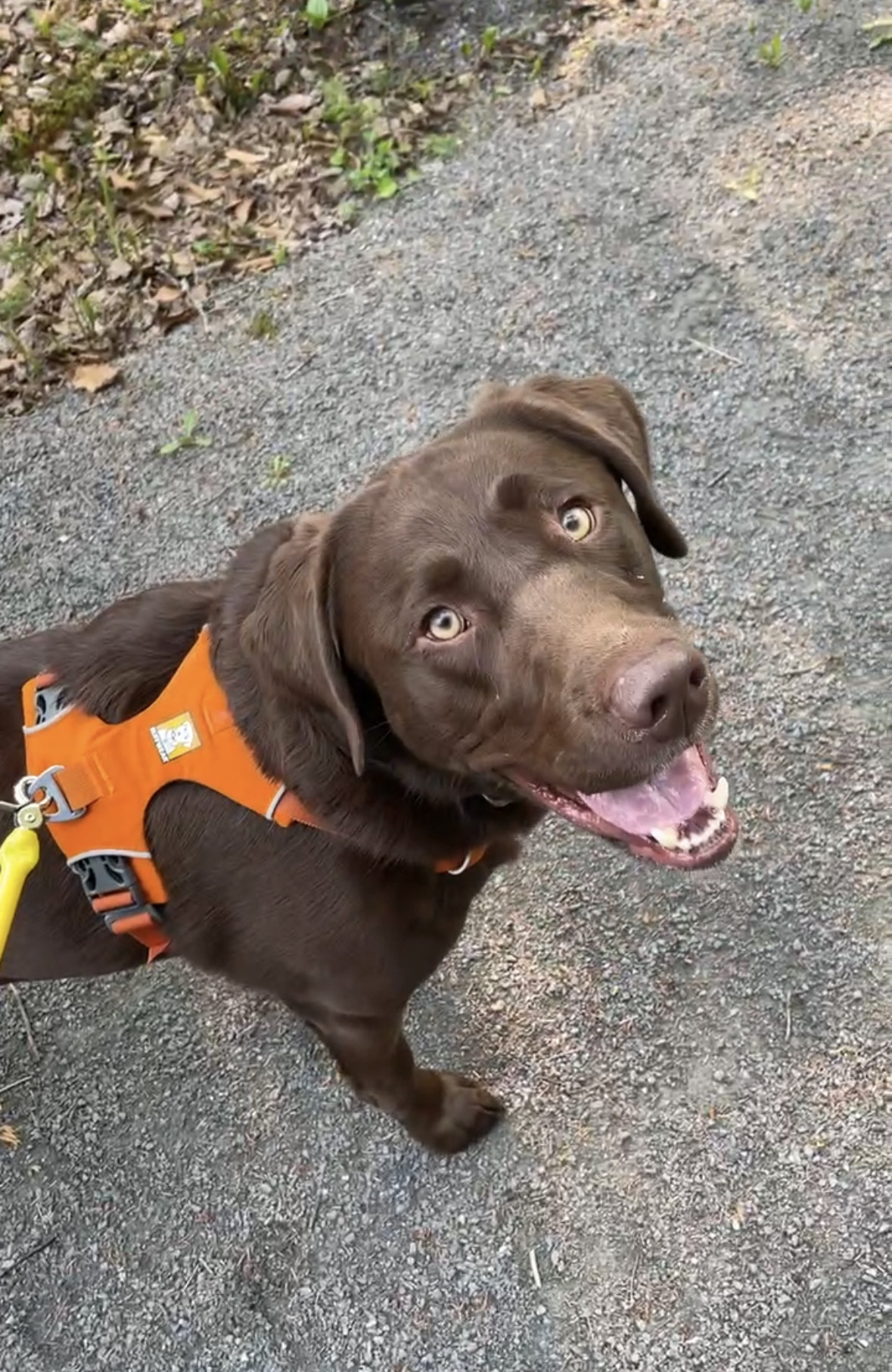 Biking with Moose!
Biking with Moose!
15. What Are The Benefits Of Biking With My Dog On A Leash?
Biking with your dog on a leash provides numerous benefits, including exercise, mental stimulation, bonding, and adventure.
- Exercise:
- Physical Activity: Biking provides a great form of exercise for both you and your dog, improving cardiovascular health and muscle strength.
- Weight Management: Regular exercise helps maintain a healthy weight, preventing obesity-related health issues.
- Mental Stimulation:
- New Experiences: Biking exposes your dog to new sights, sounds, and smells, providing mental stimulation.
- Reduces Boredom: Mental stimulation reduces boredom, preventing destructive behaviors.
- Bonding:
- Quality Time: Biking provides an opportunity to spend quality time with your dog, strengthening your bond.
- Shared Experiences: Shared experiences create lasting memories.
- Adventure:
- Exploring New Places: Biking allows you to explore new places, discovering hidden trails and scenic routes.
- Outdoor Fun: Enjoy the outdoors, appreciating nature and fresh air.
Now that you’re equipped with the knowledge, it’s time to gear up and explore the world of biking with your furry friend. Remember to visit usabikers.net for more resources, tips, and community support to enhance your biking experience. Join our community, share your adventures, and discover even more ways to enjoy the open road with your canine companion.
Address: 801 Sturgis Main St, Sturgis, SD 57785, United States. Phone: +1 (605) 347-2000. Website: usabikers.net.
FAQ
-
What is the best type of leash for biking with a dog?
The best type of leash for biking with a dog is a specialized bike leash that attaches to the bike frame or seat post, keeping your dog a safe distance away and preventing entanglement.
-
Is it safe to use a regular leash while biking with my dog?
No, it is not safe to use a regular leash while biking with your dog, as it can compromise steering and balance.
-
What type of harness is recommended for biking with a dog?
A well-fitted harness that distributes pressure evenly is recommended for biking with a dog, preventing strain on their neck.
-
What basic commands should my dog know before biking?
Before biking with your dog, they should know basic commands such as “sit,” “stay,” “heel,” and “wait,” ensuring control.
-
How do I introduce my dog to the bike?
Introduce your dog to the bike gradually, starting with stationary exposure, progressing to short walks, and eventually introducing short rides.
-
What should I do if my dog shows signs of fatigue while biking?
If your dog shows signs of fatigue while biking, slow down your pace, take breaks, and shorten your ride as needed.
-
How do I choose a dog-friendly biking route?
Choose dog-friendly biking routes that permit dogs, have minimal distractions, and offer safe surfaces such as paved or gravel paths.
-
How does temperature affect biking with my dog?
Temperature significantly affects biking with your dog, so avoid biking during extreme heat or cold, as dogs are more susceptible to temperature-related health issues.
-
What are some safety tips for biking with my dog on a leash?
Some safety tips for biking with your dog on a leash include wearing a helmet, using hand signals, installing a bike bell, and staying vigilant.
-
What if my dog doesn’t like biking?
If your dog doesn’t like biking, don’t force them, find alternative activities that you can enjoy together, such as hiking or swimming.
